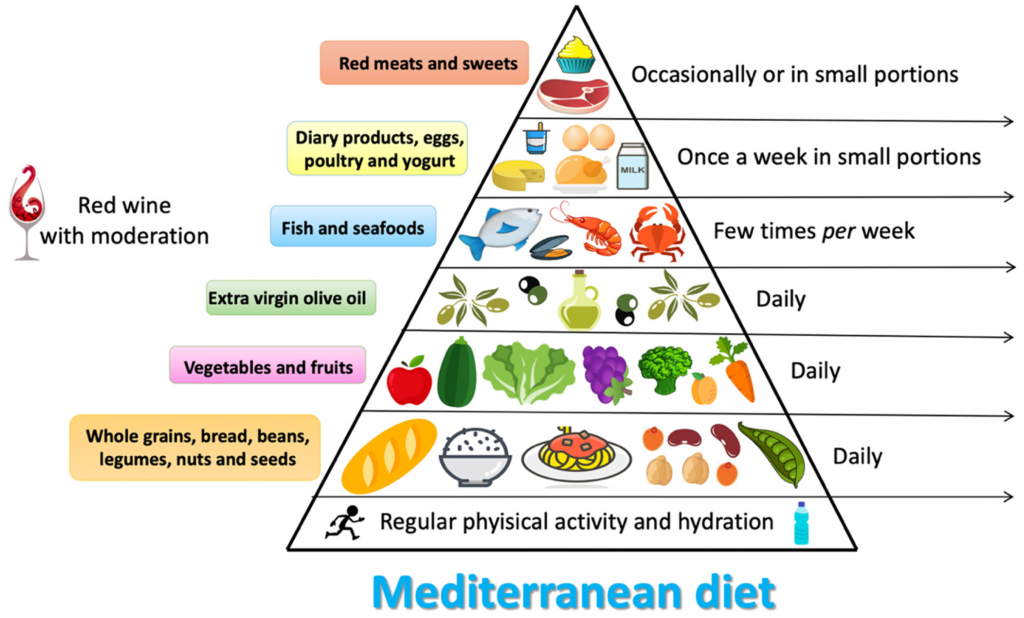We have discussed many of the great benefits of the Mediterranean Diet.
Pros
- Balanced and flavorful
- Promotes heart health
- Supports diabetes prevention and management
- Has mental health benefits
- Aids in Weight management
- Reduces inflammatory markers
- Associated with cancer prevention
- Environmentally friendly
BUT… there are a few cons as well.
Cons
- Some foods are costly
- Additional guidance may be necessary for certain conditions
- Some dietary restrictions may be challenging
- Allows alcohol intake
- May fall short on some nutrients
- No specific guidelines to follow
- Can be time-consuming
For some people, there may be a few drawbacks to the Mediterranean diet. However, many of these are surmountable.

Cost
There are no expensive branded foods or special supplements that you are required to buy on the Mediterranean diet. But some consumers express concern about the cost of some foods, including fish, seeds, nuts, and olive oil.
For example, fresh seafood tends to be more expensive than other proteins. However, there are several ways to shop on a budget—even for seafood.
Cost-Saving Tips
To keep costs down, Toups recommends shopping sales at the grocery store. For example, many recipes that call for a specific variety of fish like cod or seabass can often be made with a local catch that may be a bit cheaper or on sale.
Don’t discount frozen seafood either. It is often less expensive than fresh and, when thawed, cooks up beautifully. Canned fish is another cost-effective option.
Additional Guidance May Be Needed
Even though studies suggest that a Mediterranean diet may reduce diabetes risk and support better blood sugar control, some people with diabetes may need additional guidance while on this diet.
Because there is an emphasis on grains, fruits, and vegetables (including starchy vegetables), meals may be high in carbohydrates. It’s important for people with diabetes to eat a consistent, controlled amount of carbohydrates throughout the day to avoid blood sugar spikes or dangerously low sugars (if you’re using insulin or certain oral medications).
This does not mean people with diabetes shouldn’t follow this plan. On the contrary, it can be a great choice. If you have diabetes, though, try working with a dietitian to help you plan the right carbohydrate counts for your meals within the greater framework of the Mediterranean diet.
Restrictions May Feel Challenging
This diet recommends reducing red meat and added sugar consumption, which may be difficult for some people. Those who are used to the standard American diet may consume added sugar in processed foods on a regular basis. Those following the Mediterranean diet are advised to save added sugar for special occasions.
Keep in mind any added sugar reduction is beneficial, so don’t let this deter you. Following a Mediterranean-style diet that contains a little added sugar is still more beneficial than following a Western-style diet that’s high in added sugar.
Similarly, if you’re struggling with eating red meat less often, try following this diet while incorporating lean and unprocessed red meats like flank, top round, and brisket half flat, but in smaller portions. Research suggests you’ll still reap heart-health benefits.
Concerns About Alcohol Intake
Some experts raise concerns about the regular alcohol intake (particularly wine) in the Mediterranean diet and whether this is truly beneficial to recommend.19 Toups believes it can be. “When alcohol is consumed as part of a balanced meal, and coupled with daily movement and social connections, studies find a net health benefit,” she says.
“The Mediterranean diet and other traditional diets present examples of how to safely enjoy alcohol in moderation (up to one 5-ounce glass of wine per day for women, or up to two 5-ounce glasses daily for men), in a way that may support cardiometabolic health and help to foster positive social connections,” says Toups.
But what about when alcohol is consumed in other scenarios? “When alcohol intake is accompanied by unhealthy habits, like smoking or poor diet, or unsafe habits, like driving, obvious health risks present themselves,” she says.
The current edition of the USDA Dietary Guidelines for Americans does not recommend that people who do not currently drink alcohol start drinking, but for adults who do choose to drink alcoholic beverages, it is noted that drinking less is better for health than drinking more. When adults choose to drink, the USDA recommends one drink or less per day for women and two drinks or less for men.
May Fall Short on Some Nutrients
The USDA notes that most Americans do not get enough calcium and vitamin D in their diets. Those who choose to follow the Mediterranean lifestyle tend to consume less dairy, so they’ll want to ensure they get enough of these nutrients from other sources.
One study found that Spanish children who had low adherence to the Mediterranean diet don’t get enough calcium to reach recommended intake levels even when dairy foods were used to compensate for the low adherence. Researchers determined this was because other foods containing calcium were not being consumed.
Fortunately, dairy is not the only source of calcium and vitamin D. There are many other sources including fortified milk alternatives, particularly soy milk and other soy products, as well as fortified orange juice, some whole-grain cereals, seafood, spinach, soybeans, or sesame seeds. Foods like these are encouraged on the Mediterranean diet.
Studies have also shown that both adults and children who adhere to this healthy pattern are likely to have a better nutrient profile, with a lower prevalence of individuals showing inadequate intakes of micronutrients.
No Specific Guidelines
Unlike many other eating patterns, the Mediterranean diet does not provide specific calorie counts, food portion sizes, or strict lists of foods to eat and foods to avoid. There is also no singular source for following this diet.
For some who prefer a more structured eating style (especially for weight loss or weight maintenance), this may present a challenge. However, the Healthy Mediterranean-Style Eating Pattern provided by the USDA can be used as a guide for those who prefer a more specific approach.
To use the guide, simply choose the calorie goal that aligns with your dietary needs then choose a variety of foods in each group and consume them over time in recommended amounts. Calorie targets for healthy adults are provided ranging from 1,600 calories per day to 3,200 per day, which vary based on age, sex, weight, and level of physical activity.
May Be Time Consuming
Shopping for Mediterranean diet foods and preparing meals is likely to take more time than heating up prepared foods or grabbing fast food on the go. On this diet, processed foods are discouraged, while balanced meals made with whole ingredients are encouraged.
Certainly, this shift may take some adjustment for some people. But many people learn to love cooking and preparing meals for themselves or their families. Additionally, you can prepare large quantities of foods in advance to use at meals later.
Journal Entry – “Daily Thoughts”
How are you feeling?
- Did you find this week easier or harder to follow along to?
- Have noticed any changes in your clarity, improved brain fog?
- Be sure and take notice of the specific areas of these guidelines that you would be able to incorporate on a daily basis.


